food-growing sites. Artist-in-residence Rosie Potter explains.

Appropriately named, Recreation Road, in Southall, West London, is undergoing a transformation thanks to an inspiring creative gardening project. Involved are children and practitioners from Greenfields Children's Centre, together with members of the local community, supported by artists-in-residence - myself and Kirstie Reid of Wimbledon College, University of the Arts London.
The project Veg St UB2 (after the local postcode) began early in March 2014 with artists following the children's interest in planting and growing. The children began by creating their own small market garden at the nursery, enthusiastically growing, mostly from seed, a whole range of organic produce including herbs, beans, strawberries, tomatoes, potatoes, garlic, marrows, peppers and aubergines. The plot was so productive that children were keen to share their bounty and their excitement in growing vegetables with our neighbours on Recreation Road.
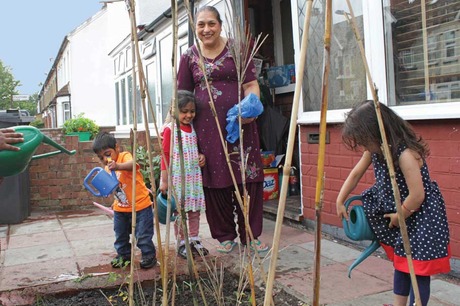
To propose the initial engagement, the children firstly designed and produced a flier, then small groups of 'explorers', together with a practitioner and an artist, visited the 20 houses that form the 'gateway' to Recreation Park and the children's centre. The invitation to individual householders was to become part of the project by allowing us to grow flowers, fruit and vegetables in their front gardens.
At first, some residents were a little cautious and not all wished to participate. However, as front gardens began to blossom with foliage and flowers, benefiting from the delivery of new plants each week, accompanied by regular visits from the children to water, feed and if necessary de-bug them, no one wanted to be left out.
In some cases, healthy competition arose between neighbours, comparing the number and range of plants that they had received and the comparative aesthetic quality of the containers. Most of these had been sourced as donations and ranged from chests of drawers, disused paper recycling bins, saucepans and washing-up bowls to teapots, shopping baskets, small suitcases and car tyres.
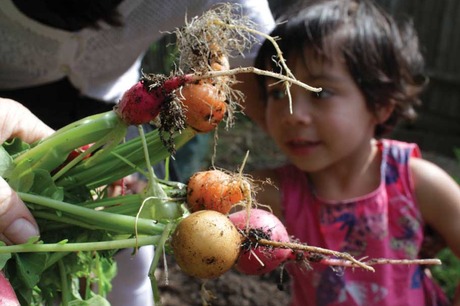
Within this full and generous collaboration, the children enjoyed getting to know the local residents, and in response our neighbours began to voluntarily clear front gardens in preparation for the plantings, sometimes leaving containers outside, including in one case a large work boot. So, in quite a short space of time the project became a topic of local interest and engagement, across generations as well as garden walls.
Doors opened, and advice and growing tips were exchanged. Neighbours began to take responsibility for their own plants while showing their appreciation through small gifts of sweets for the children and by offering refreshments and engaging in conversation with them as they worked in their gardens.
Children and parents, seeing the vibrant progress of the street gardens on their way to and from nursery, began to develop their own gardens at home, sharing knowledge and an appreciation of the possibilities of growing and eating really fresh and abundant crops that require only small spaces and a few pots in which to flourish.
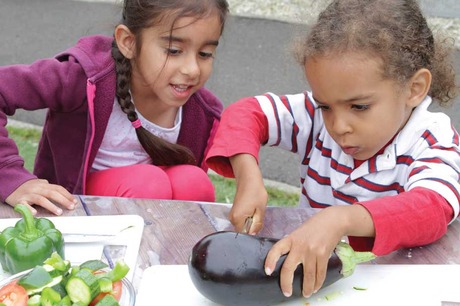
PHILOSOPHY GROUP
News of home growing was often the elected starting point for the children's philosophy group and led to conversations about the naming of plants and insects and their behaviours, the recognition of species, germination, the nature and speed of growth itself - what is happening above and below ground - the needs and care of all living things, the seasons, weather conditions, drainage and the life cycle from birth to death. Children considered the ways in which all these various states might be observed, described and measured through language, drawing and numerical calculation.
As the summer wore on and bright yellow flowers turned into marrows, tomatoes ripened and long runner beans began to hang down over doorways, it became clear that all the hard work was paying off and we needed to celebrate the collective achievements. A festival to mark the harvest of the fruits and vegetables was arranged and held in the front garden at Greenfields on a glorious sunny day in July.
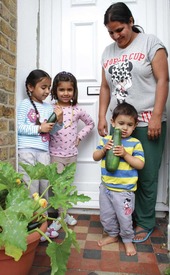
Recreation Road Ratatouille, a delicious vegetable dish which children had helped to create, was cooked outside on an open stove and offered together with a potato salad, followed by strawberries on mint leaves. The entire meal represented all the vegetables and fruits that had been grown throughout the course of the project and an exhibition of photographs charted its progress.
Our 'Community Gardeners' were invited as special guests and altogether, with children and parents, 200 servings of food were sampled and enjoyed that day.
Every child took home a copy of the simple ratatouille recipe as a reminder of the positive pleasures of planting, nurturing and producing something themselves 'from seed to plate'. It illustrated too how this cycle of environmentally friendly production and nutrition is accessible to city dwellers and may herald the emergence of a whole new generation of 'urban farmers' in the future.
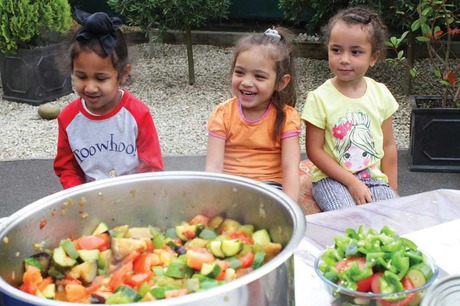
SUSTAINABLE SELF-SUFFICIENCY
The ongoing project Veg St UB2 encourages all contributors to consider the benefits of living a life of sustainable self-sufficiency, a message that is being echoed loudly both nationally and internationally.
Perhaps more importantly at a local level, it also sparks in us a shared desire to make the communities in which we live attractive and productive, by gathering with neighbours and sharing a vested interest in making our surroundings increasingly inviting and the urban space much greener.
This, in turn, has the potential to inspire and foster better intergenerational social relationships, as well as to stimulate positive connections with plant, bird and insect life, creating an environment where everyone is more relaxed and perhaps freer to be kind, friendly and more generous towards one another and where feelings of isolation are diminished by a sense of fellowship and harmony.
With thanks to the Southall Community Alliance and friends from Southall Community Garden for their kind support in making Veg St UB2 such a brilliant project for all those involved. Greenfields Children's Centre was classified as outstanding at a recent Ofsted inspection with a special mention for the quality of its creative programme.
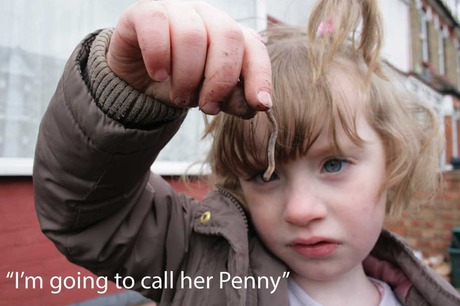
GARDENING: WHERE TO FIND INFORMATION
Ready, Steady Grow, Grow it, Eat it and Wildlife Garden - three colourful guides for gardening with children, all written by experts at the Royal Horticultural Society.
The Playground Potting Shed by Dominic Murphy - this award-winning book relates how Murphy helped his local school establish a garden and grow an array of flowers, fruit and vegetables.
Gardening with Children by Kim Wilde - a comprehensive guide to making the garden fun and educational.
Eddie's Garden and How to Make Things Grow by Sarah Garland - a clear and gentle insight into the essentials for making plants grow. Includes information on growing a garden like Eddie's in a home garden or even indoors. See also Doing the Garden, part of Garland's classic picture book series.
Planting a Rainbow by Lois Ehlert - an educational and enjoyable book that helps children understand how to plant bulbs, seeds and seedlings, and to nurture their growth. See also Ehlert's Growing Vegetable Soup and Eating the Alphabet.
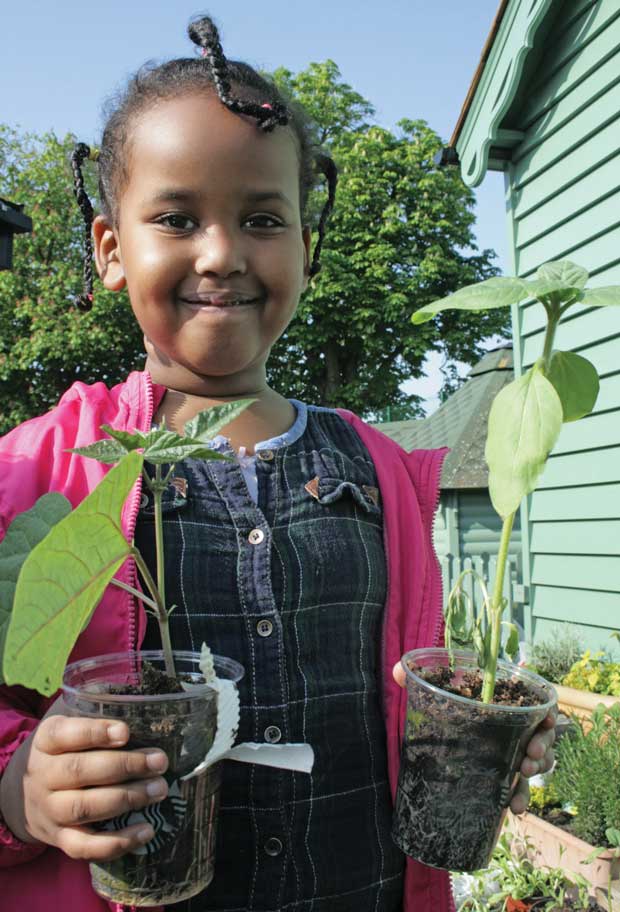
Fruit and vegetables
The Vegetables We Eat by Gail Gibbons - follows leaf, root and stem vegetables from planting to the shops. Includes information on how to tend your own garden.
I Eat Vegetables! and I Eat Fruit! by Hannah Tofts and Rupert Horrox - bright and colourful insights, above and below the skin.
The Surprise Garden by Zoe Hall and Shari Halpern - children watch the progress of plants from small shoots to tasty vegetables.
Jasper's Beanstalk by Nick Butterworth and Mick Inkpen - Jasper the cat finds a bean and plants it.
Jack and the Baked Beanstalk by Colin Stimpson - a gorgeous retelling of the traditional tale.
Strega Nona's Harvest by Tomie dePaola's - Strega Nona attempts to teach Big Anthony about gardening, but when he ignores her instructions and tries his own growing spell, his vegetable patch turns into a jungle.
Oliver's Vegetables and Oliver's Fruit Salad by Vivian French - picture book classics.
Flowers
Flower Garden by Eve Bunting - a father and child lovingly plant a 'garden' of flowers in a window box as a birthday surprise for mum.
Katie and the Sunflowers by James Mayhew - Katie tries to pick the sunflower seeds from the Vincent Van Gogh painting.
The Flower Alphabet Book by Jerry Pallotta - an A to Z of illustrated flowers.
A Little Guide to Wild Flowers by Charlotte Voake - a child-friendly guide to wild flowers by the Eden Project.
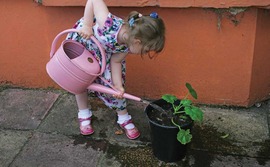
Websites
The Royal Horticultural Society's website, www.rhs.org.uk, provides a wealth of information including a beginner's guide to gardening and activities for children.
www.littlegreenfingers.com is dedicated to getting children hooked on gardening.
Learn about nurturing vegetables and more at www.bbc.co.uk/cbeebies/mr-blooms-nursery.









